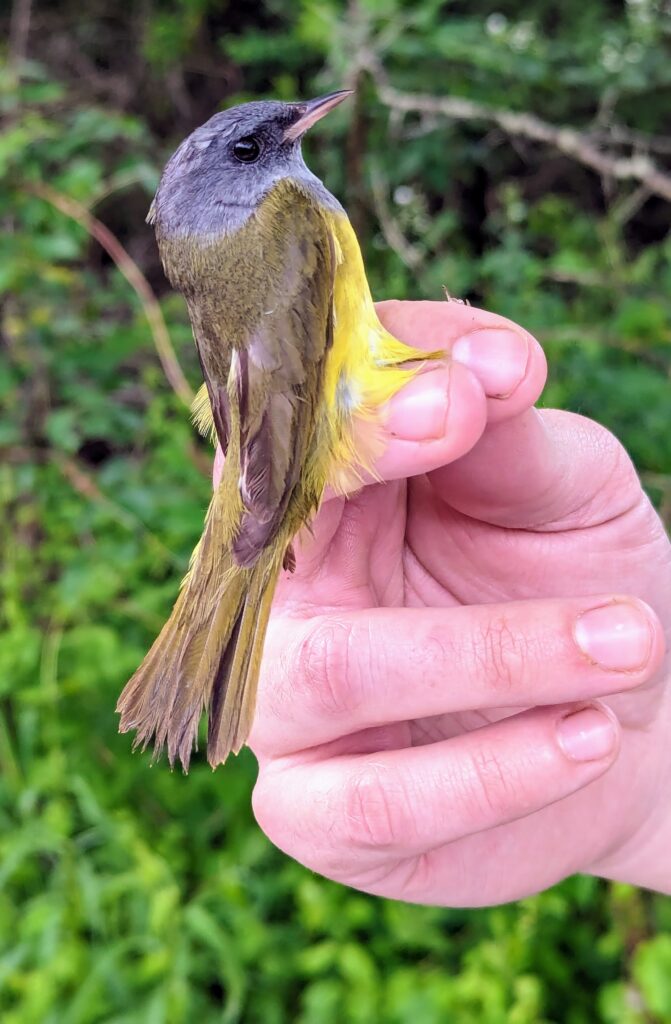Always expect the unexpected. While you often expect to find certain things, there are inevitably the times where you will find yourself with a chill up your spine
If you prefer to listen to this blog, simply click on the play button below.
May 18, 2024
The pre-dawn began just like any other of the past, low clouds, not a drop of wind, but a thick cloud cover with understory floating islands of fog hugging the slopes of the hillside just beyond our parked cars. The threat of rain was probable as it had been for the past several weeks of Spring. There was one thing different about this morning though. Was it the trees that had finally leafed out? Was it that we finally left our jackets behind at home? Perhaps, that or perhaps we were full tilt into Spring migration.
We made our way through the restored habitat that at one time was a forest, later becoming an agricultural field, now again regaining its foothold as a forest. Our equipment doesn’t carry itself after all, and we set up and take down every time we are out in the field. As we arrived at the banding station with our equipment, the usual suspects were heard in the canopy, the sharp twill of the Eastern Towhee we dubbed “Earl Gray”, and an exceptionally operatic Brown Thrasher was our songster. We also heard off to one side (if your ear was trained enough to catch the song) a Blue-Winged Warbler, but I am not familiar with his tune. Today has got to be the day that warbler finds its way to be banded. Hopes were high but the clouds remained low. I can tell you that in fact, fate did have its way to bring that bird in, but I still need some practice identifying their “bee-buzz” sounds.
There is a way to solidify the ID through the ear, but it really requires a special amount of time in the field. Like memorizing the lyrics to a song, the job is made much quicker by reading the words on a page while the song is being sung. Of course there are challenges. The Blue-winged Warbler sounds more like a high pitched buzz than a song which can certainly be hard to pinpoint out of a field full of whistles, clicks, and chatter of the dawn song.
Birding Tip #1:
In order to learn an ID by sound, this task requires binoculars on the bird whilst the bird is singing. At least for me anyway. I find this to be the best way to increase your lifetime appreciation of such birds. Especially ones like warblers and towhees, with their strong preference for hiding in high canopy and low underbrush, respectively. Better still, learn the birding vernacular for its song, like the Ovenbirds’ “Teeeacher, Teeeacher, Teacher…….” Or the Indigo Buntings’ intense “Fire, fire, where? where? Here, here, see it, see it?” To see a bird, you may make out only half the population, to hear a bird you are increasing your likelihood of a much more robust lifer list. For example, the Spring perimeter of my yard is continually punctuated by the Common Yellowthroat. I hear it constantly, witchety-witchety-witchety. This is how many times I have seen one in my yard: uno.
One bird I was hoping to see today was the Great Crested Flycatcher. They have a very unique call that sounds midway between a large frog and a small dinosaur. The sound is so unusual in fact that it doesn’t seem too far off to imagine living among such creatures of the long gone past. A slender bird with a dull yellow chest and a brownish-gray back, a long slender tail, and a not-so crested crest on their head, singing to them is more of a squawk in between their darting out and about to dine on insects in mid-flight.
Birding Tip #2:
Always expect the unexpected. While you often expect to find certain things, there are inevitably the times where you will find yourself with a chill up your spine or the unshakable moment that what you just saw was, well, “Did I really just see that?” Expectations aside, the absolute thrill of finding a new bird takes it all out of you. Throughout the remainder of the day, you’re walking on a cloud.
I suppose some golfers find that each time they step up to a course, there is always that possibility of the nearly unimaginable hole-in-one. Or the times when a routine whale watching trip heads out into the Sea of Cortez and a pod of False Killer Whales completely surprises everyone, including the Captain. More recently, the rare “white” Killer Whale named Frosty just reappeared in California after having not been seen for over a year. The thrill is visible practically through the internet.
Today was going to be one of those days. A first to the station, which it was, but also the first time I have ever heard of, or for that matter, ever seen this type of bird. My cloud-walking was about to commence.

This bird is a rare sight for two reasons. Maybe more. One, they don’t reside in New Jersey, at any time of year. They simply use the corridor as a travel route much like those people who spend their summers in Vermont and their winters in Florida, New Jersey is simply a thruway. It prefers Canada and central and South America as its preferred homes. Two, this bird is a low, secretive bird. Finding their preferred real estate in the low, dense, shrubbery. When it came to the station I was completely floored.
I had never before seen this bird. What was it? I had no clue, beyond the warbler part. But even then, perhaps it was a fly-catcher? It had the tell tale signs of a warbler though. Bright, ecstatic plumage in spots to match their notorious fidgety behavior, mixed in with duller looking plumage. Small, and a short, pointy beak. When the ID finally came through as an announcement (with both fervid excitement and quiet “is this for real?”) for those of us who were not familiar with it, I couldn’t put my emotions in check. What was it? Glee? Shock? Butterflies? It was all of it. The luck of the moment, a Mourning Warbler will from now on remind me, that morning in May where I walked on a cloud the rest of the day. An alarm at 4:15 am is all the more worth it on mornings such as this. It wasn’t just a good morning, it was a great one.

The Wild Bird Research Group, Inc. is a 501 (c)(3) non-profit organization whose mission is to conduct and support research and science-based conservation initiatives that benefit birds and their habitats in the Americas. WBRG and its associates conduct various research, monitoring and education programs in the Mid-Atlantic U.S. and Central America, tropical bird banding internships for university students, owl migration and winter ecology research, and bird-focused environmental interpretive programs.
No responses yet